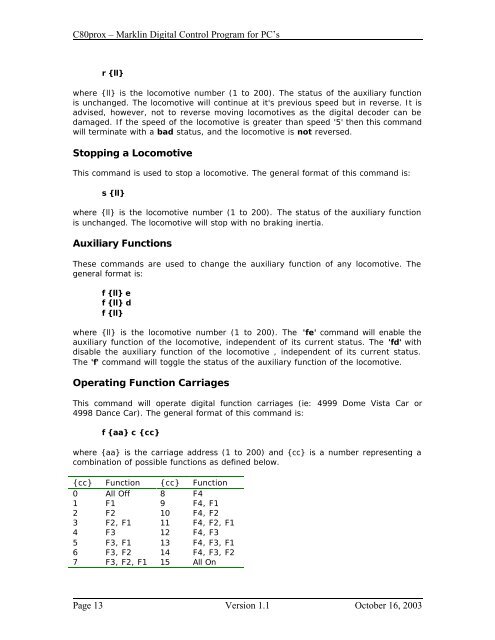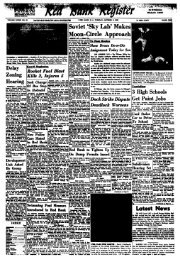C80prox Marklin Digital Control Program for PC's
C80prox Marklin Digital Control Program for PC's
C80prox Marklin Digital Control Program for PC's
You also want an ePaper? Increase the reach of your titles
YUMPU automatically turns print PDFs into web optimized ePapers that Google loves.
<strong>C80prox</strong> – <strong>Marklin</strong> <strong>Digital</strong> <strong>Control</strong> <strong>Program</strong> <strong>for</strong> PC’s<br />
r {ll}<br />
where {ll} is the locomotive number (1 to 200). The status of the auxiliary function<br />
is unchanged. The locomotive will continue at it's previous speed but in reverse. It is<br />
advised, however, not to reverse moving locomotives as the digital decoder can be<br />
damaged. If the speed of the locomotive is greater than speed '5' then this command<br />
will terminate with a bad status, and the locomotive is not reversed.<br />
Stopping a Locomotive<br />
This command is used to stop a locomotive. The general <strong>for</strong>mat of this command is:<br />
s {ll}<br />
where {ll} is the locomotive number (1 to 200). The status of the auxiliary function<br />
is unchanged. The locomotive will stop with no braking inertia.<br />
Auxiliary Functions<br />
These commands are used to change the auxiliary function of any locomotive. The<br />
general <strong>for</strong>mat is:<br />
f {ll} e<br />
f {ll} d<br />
f {ll}<br />
where {ll} is the locomotive number (1 to 200). The 'fe' command will enable the<br />
auxiliary function of the locomotive, independent of its current status. The 'fd' with<br />
disable the auxiliary function of the locomotive , independent of its current status.<br />
The 'f' command will toggle the status of the auxiliary function of the locomotive.<br />
Operating Function Carriages<br />
This command will operate digital function carriages (ie: 4999 Dome Vista Car or<br />
4998 Dance Car). The general <strong>for</strong>mat of this command is:<br />
f {aa} c {cc}<br />
where {aa} is the carriage address (1 to 200) and {cc} is a number representing a<br />
combination of possible functions as defined below.<br />
{cc} Function {cc} Function<br />
0 All Off 8 F4<br />
1 F1 9 F4, F1<br />
2 F2 10 F4, F2<br />
3 F2, F1 11 F4, F2, F1<br />
4 F3 12 F4, F3<br />
5 F3, F1 13 F4, F3, F1<br />
6 F3, F2 14 F4, F3, F2<br />
7 F3, F2, F1 15 All On<br />
Page 13 Version 1.1 October 16, 2003




